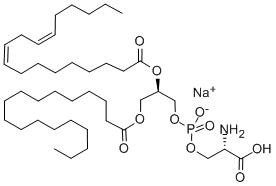DODAP
Synonym(s):1,2-dioleoyl-3-dimethylammonium-propane (DODAP)
- CAS NO.:127512-29-2
- Empirical Formula: C41H77NO4
- Molecular Weight: 648.05
- MDL number: MFCD01321074
- SAFETY DATA SHEET (SDS)
- Update Date: 2024-11-04 20:04:50

What is DODAP?
Description
DODAP (18:1) is an ionizable cationic lipid with lower cytotoxicity and high transfection efficiency. DODAP is neutral at physiological pH, but acquires a positive charge inside the endosome due to the protonation of free amines when pH is lower than its pKa (<7).
Chemical properties
Light Yellow Oil
The Uses of DODAP
Cationic amphiphiles are being studied for their potential role in preparing liposomes for interaction with artificial and biological membranes and cellular transfection techniques. Cationic species with ester linkages to the hydrophobic portion are more easily degraded by recipient cells and more efficiently metabolized.
Properties of DODAP
| Boiling point: | 670.1±55.0 °C(Predicted) |
| Density | 0.916±0.06 g/cm3(Predicted) |
| storage temp. | -20°C Freezer, Under Inert Atmosphere |
| solubility | Chloroform (Slightly), Ethyl Acetate (Slightly), Methanol (Slightly) |
| form | Oil |
| pka | 8.02±0.28(Predicted) |
| color | Colourless to Light Yellow |
| Stability: | Light Sensitive; Hydroscopic; Store at -15 to -25°C |
Safety information for DODAP
| Signal word | Danger |
| Pictogram(s) |
 Skull and Crossbones Acute Toxicity GHS06  Health Hazard GHS08 |
| GHS Hazard Statements |
H302:Acute toxicity,oral H315:Skin corrosion/irritation H319:Serious eye damage/eye irritation H331:Acute toxicity,inhalation H336:Specific target organ toxicity,single exposure; Narcotic effects H351:Carcinogenicity H372:Specific target organ toxicity, repeated exposure |
| Precautionary Statement Codes |
P202:Do not handle until all safety precautions have been read and understood. P301+P312:IF SWALLOWED: call a POISON CENTER or doctor/physician IF you feel unwell. P302+P352:IF ON SKIN: wash with plenty of soap and water. P305+P351+P338:IF IN EYES: Rinse cautiously with water for several minutes. Remove contact lenses, if present and easy to do. Continuerinsing. P308+P313:IF exposed or concerned: Get medical advice/attention. |
Computed Descriptors for DODAP
| InChIKey | NYDLOCKCVISJKK-WRBBJXAJSA-N |
| SMILES | C(OC(=O)CCCCCCC/C=C\CCCCCCCC)(CN(C)C)COC(=O)CCCCCCC/C=C\CCCCCCCC |
New Products
4-AMINO-TETRAHYDRO-PYRAN-4-CARBOXYLIC ACID 4-Aminotetrahydropyran-4-carbonitrile Hydrochloride (R)-3-Aminobutanenitrile Hydrochloride 4-AMINO-TETRAHYDRO-PYRAN-4-CARBOXYLIC ACID HCL 1,4-Dioxa-8-azaspiro[4.5]decane 5-Bromo-2-nitropyridine SODIUM AAS SOLUTION ZINC AAS SOLUTION BUFFER SOLUTION PH 10.0(BORATE) GOOCH CRUCIBLE SINTERED AQUANIL 5 BERYLLIUM AAS SOLUTION INOSITOL PANTOPRAZOLE SODIUM SESQUIHYDRATE Metformin FLUCLOXACILLIN SODIUM STERILE NIMESULIDE BP ZONISAMIDE 1,1-Dimethylethyl 4-(2-azidoacetyl)-1-piperidinecarboxylate 2-Bromo-1-(bromomethyl)-3-iodo-5-nitrobenzene 1,2-Dibromo-3-(bromomethyl)-5-nitrobenzene 2-Cyano-5-pyrimidineacetonitrile 7-Fluoro-4-cinnolinamine 2-Bromo-1-(bromomethyl)-3-chloro-5-nitrobenzeneRelated products of tetrahydrofuran

![1-OCTADECANOYL-2-[CIS-9-OCTADECENOYL]-SN-GLYCERO-3-PHOSPHOCHOLINE](https://img.chemicalbook.in/CAS/GIF/56421-10-4.gif)


![Hexadecanoic acid, 1,1'-[(1S)-1-[[[(2-aminoethoxy)hydroxyphosphinyl]oxy]methyl]-1,2-ethanediyl] ester](https://img.chemicalbook.in/CAS/20211123/GIF/71357-99-8.gif)

![1,2-dipalMitoyl-sn-glycero-3-phosphoethanolaMine-N-[3-(2-pyridyldithio)propionate] (sodiuM salt)](https://img.chemicalbook.in/CAS/20150408/GIF/474944-16-6.gif)

You may like
-
 18:1 DAP CAS 127512-29-2View Details
18:1 DAP CAS 127512-29-2View Details
127512-29-2 -
 18:1 DAP CAS 127512-29-2View Details
18:1 DAP CAS 127512-29-2View Details
127512-29-2 -
 1823754-06-8 98%View Details
1823754-06-8 98%View Details
1823754-06-8 -
 2-Chloro-5-(iodomethyl)pyrimidine 2268818-88-6 98%View Details
2-Chloro-5-(iodomethyl)pyrimidine 2268818-88-6 98%View Details
2268818-88-6 -
 2092793-98-9 98%View Details
2092793-98-9 98%View Details
2092793-98-9 -
 1360944-55-3 7-Methoxy-1H-indol-5-amine 98%View Details
1360944-55-3 7-Methoxy-1H-indol-5-amine 98%View Details
1360944-55-3 -
 2090480-14-9 98%View Details
2090480-14-9 98%View Details
2090480-14-9 -
![1-Methyl 2-bromo-5-[(1-carboxy-1-methylethyl)amino]benzoate 1651844-56-2 98%](https://img.chemicalbook.in//Content/image/CP5.jpg) 1-Methyl 2-bromo-5-[(1-carboxy-1-methylethyl)amino]benzoate 1651844-56-2 98%View Details
1-Methyl 2-bromo-5-[(1-carboxy-1-methylethyl)amino]benzoate 1651844-56-2 98%View Details
1651844-56-2
Statement: All products displayed on this website are only used for non medical purposes such as industrial applications or scientific research, and cannot be used for clinical diagnosis or treatment of humans or animals. They are not medicinal or edible.